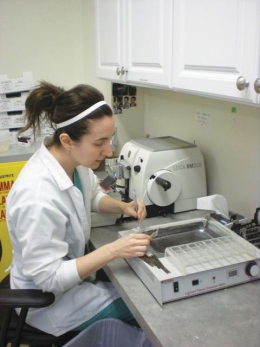
Jeffrey Coldren’s office is overtaken with event programs, name badges and a to-do list. Since submissions for QUEST: A Forum for Student Scholarship closed on March 23, his life has revolved around organizing the event.
Although the event was booked a year in advance, Coldren, a professor of psychology at Youngstown State University, said he couldn’t piece it together until all of the submissions were finalized.
The event takes place in Kilcawley Center on Tuesday, and every college at YSU will be represented.
“We try to emphasize that student scholarship and faculty interaction is different in every college,” Coldren said. “If they’re doing a project that advances the state of knowledge, then it counts as scholarship. This is really a broad diversity of projects and a lot of intellectual diversity.”
Sal Sanders, an associate professor of health professions, is on the QUEST committee and is one of the judges for the final awards.
Deans award one group from each college, while all participants compete for a single undergraduate and graduate award.
“There are more students that are doing the researching,” Sanders said. “The quality of the presentations is remarkable.”
Sanders also served as a faculty sponsor for three of the student presentations.
Graduate student Marlene Mears is presenting her research on how different cell tissues react to different forms of fixatives, which keep human tissue samples intact during research.
SafeFix II and 10 percent neutral buffered formalin are fixatives she compared for her study.
She said the 10 percent NBF is what is commonly used today, but it has side effects, such as watery, burning eyes, sore throat and dry sinuses.
The alternative, SafeFix II, does not have as many side effects.
She obtained different tissue samples from the human spleen, brain, liver and uterus.
“One reason overall was the safety of the health care workers because we are exposed to this around 20 hours a day, and it’s affecting our health,” Mears said. “At the same time, you don’t want to mess up the morphology of the patient tissue. We want to be sufficient but not hinder the patients.”
Mears has been working on this project since the summer as a part of her master’s degree program. She also works as a histotechnologist at a dermatologist’s office, where she studies body tissue.
Sanders said he is looking forward to seeing Mears’ presentation, as well as presentations from other colleges.
Meanwhile, Coldren is looking forward to keynote speaker George Newkome, vice president of research and dean of the graduate school at the University of Akron.
“You really can’t do research like this without teamwork. This was a good opportunity to get a different perspective,” Coldren said.
Coldren said he is excited for the presentations to begin so he can sit back and enjoy.
“When QUEST begins, my work is done,” Coldren said.
QUEST presentations begin Tuesday at 8:30 a.m. and end at 5 p.m.

